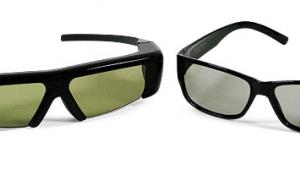Passive Polarization

Let There Be Polarized Light
Before we get to polarized 3D, we need to understand a little physics of light. Visible light is a form of electromagnetic radiation, which consists of oscillating electrical and magnetic fields at right angles to each other. Normally, the orientation of these fields to the rest of the world is random, but if the oscillations are constrained to one particular orientationsay, the electrical field oscillates horizontally and the magnetic field oscillates verticallythe light is said to be polarized.
The vibrational frequency of the two fields is always the sameit determines the color of the lightbut their phase relationship can vary. If the two fields are in phase, this condition is called linear polarization as depicted in the left portion of the diagram above; if they are 90 degrees out of phase, it is called circular polarization as shown on the right. In both cases, the orange wave in the diagram is the combination of the electrical and magnetic waves.
As you can see, in linear polarization, the combination wave maintains a constant angle with respect to the electrical and magnetic waves. By contrast, in circular polarization, this angle changes over time, forming a "corkscrew" as the light travels.
In circular polarization, the electrical and magnetic fields can be 90 degrees out of phase in one of two waysthe electrical-field oscillation can be ahead of the magnetic-field oscillation or vice versa. The resulting corkscrews are called clockwise and counterclockwise because they "rotate" in opposite directions.
Polarized 3D
Okay, now that we have the background out of the way, let's see how polarization allows 3D images to be displayed. You might have already guessed that all you need to do is display the left- and right-eye images using different polarization for each one. Then, you need to wear glasses with filters that allow only light with the left-eye polarization to reach the left eye and light with the right-eye polarization to reach the right eye.
For example, you could use linear polarization, with the left-eye image being horizontally polarizedthat is, the orange combination wave in the diagram is oriented horizontallywhile the right-eye image is vertically polarized. Of course, the left filter in the glasses must let only horizontally polarized light through and the right filter must let only vertically polarized light through.
This works just fineuntil you tilt your head, which allows some of the light from both images to get through both filters, leading to unacceptable crosstalk. If you were watching the picture while lying on your side, your left eye would see the right-eye image and vice versa.
A better approach is to use circular polarizationsay, clockwise for the left-eye image and counterclockwise for the right-eye image, with corresponding filters in the glasses. In this case, you can tilt your head and still see the image. In fact, that's why most polarized 3D theaters use circular polarization.
Display Options
How are the left- and right-eye images displayed in a polarized system? In most commercial cinemas, especially those using RealD technology, a digital projector alternately displays the left- and right-eye images at a rate of 144Hz, or 72Hz per eye, using a synchronized circular polarizer that switches between clockwise and counterclockwise at the same rate. Of course, the film frame rate is 24fps, so each eye sees each frame three times.
Polarized 3D projectors for home theaters will do much the same thing, but most likely at 120Hz, or 60Hz for each eye. For 24fps movies, that means introducing 3:2 pulldown, which is not optimal. Perhaps a manufacturer will develop a 240Hz 3D projector, which would allow 120Hz for each eye and display each film frame five times, avoiding 3:2 pulldown.
Many Imax 3D theaters use two digital projectorsone for the left eye and the other for the right eyeto increase the amount of light, a very good thing for 3D on such a large screen. And for some reason I've yet to understand, they use linear polarization. The next time you attend an Imax 3D movie, try tilting your head to one side or the other during the show to see the left and right images become visible to both eyes. (If you don't see this, the theater you're in uses circular polarization.)
All polarized projection systems have one major drawbackthey require a special silver screen that preserves the polarization from the projector. Such a screen suffers from hot-spotting and color-shifting, which is not great for 3D and even worse for 2D. So the best-case scenario for a theater in which 2D and polarized 3D programs are shown is to have two screens that can be moved into position as needed. Unfortunately, I doubt that many commercial venues will go to this expense, which means that 2D movies in a polarized 3D theater will be seriously compromised.
Direct-view flat panels can also use polarization to achieve a 3D effectone such product is the JVC GD-463D10 46-inch LCD TV, which was introduced at CEDIA last year for a list price of nearly $9000. With flat panels, alternate horizontal lines on the screen are used to display the image for each eyefor example, the odd-numbered lines might be used for the left-eye image while the even-numbered lines are used for the right-eye image. Of course, this so-called "line-interleaved" approach cuts the vertical resolution for each eye in half, which is why it's not more common in consumer flat panels.
Like all 3D glasses, polarized glasses reduce the amount of light reaching your eyes, but not as much as active-shutter glasses, which close both lenses during part of each frame cycle to avoid crosstalk. This is one reason why passive glasses are used in projection systems, because they output much less light than flat panels to begin with.

















































